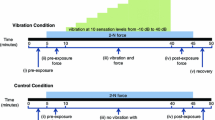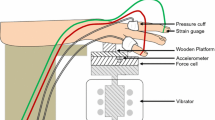Abstract
Purpose
This study investigated whether the reductions in finger blood flow induced by 125-Hz vibration applied to different locations on the hand depend on thresholds for perceiving vibration at these locations.
Methods
Subjects attended three sessions during which vibration was applied to the right index finger, the right thenar eminence, or the left thenar eminence. Absolute thresholds for perceiving vibration at these locations were determined. Finger blood flow in the middle finger of both hands was then measured at 30-s intervals during five successive 5-min periods: (i) pre-exposure, (ii) pre-exposure with 2-N force, (iii) 2-N force with vibration, (iv) post-exposure with 2-N force, (v) recovery. During period (iii), vibration was applied at 15 dB above the absolute threshold for perceiving vibration at the right thenar eminence.
Results
Vibration at all three locations reduced finger blood flow on the exposed and unexposed hand, with greater reductions when vibrating the finger. Vibration-induced vasoconstriction was greatest for individuals with low thresholds and locations of excitation with low thresholds.
Conclusions
Differences in vasoconstriction between subjects and between locations are consistent with the Pacinian channel mediating both absolute thresholds and vibration-induced vasoconstriction.




Similar content being viewed by others
References
Bolanowski SJ, Gescheider GA, Verrillo RT, Checkosky CM (1988) Four channels mediate the mechanical aspects of touch. J Acoust Soc Am 84:1680–1694
Bovenzi M, Lindsell CJ, Griffin MJ (1998) Duration of acute exposure to vibration and finger circulation. Scand J Work Environ Health 24(2):130–137
Bovenzi M, Lindsell CJ, Griffin MJ (1999) Magnitude of acute exposure to vibration and finger circulation. Scand J Work Environ Health 25(3):278–284
Bovenzi M, Lindsell CJ, Griffin MJ (2000) Acute vascular responses to the frequency of vibration transmitted to the hand. Occup Environ Med 57:422–430
Bovenzi M, Welsh AJL, Della Vedova A, Griffin MJ (2006) Acute effects of force and vibration on FBF. Occup Environ Med 63:84–91
Capraro AJ, Verrillo RT, Zwislocki JJ (1979) Psychophysical evidence for a triplex system of mechanoreception. Sens Process 3:334–352
Concettoni E, Griffin MJ (2009) The apparent mass and mechanical impedance of the hand and the transmission of vibration to the fingers, hand and arm. J Sound Vib 325(3):664–678
Egan CE, Espie BH, McGrann S, McKenna KM, Allen JA (1996) Acute effects of vibration on peripheral blood flow in healthy subjects. Occup Environ Med 53:663–669
Gemne G (1994) Diagnostics of hand-arm system disorders in workers who use vibrating tools. Occup Environ Med 54:90–95
Gescheider GA, Bolanowski SJ, Pope JV, Verrillo RT (2002) A four-channel analysis of the tactile sensitivity of the fingertip: frequency selectivity, spatial summation, and temporal summation. Somatosens Motor Res 19:114–124
Greenfield ADM, Whitney RJ, Mowbray JF (1963) Methods for the investigation of peripheral blood flow. Br Med Bull 19:101–109
Greenspan JD, Bolanowski SJ (1996) The psychophysics of tactile perception and its peripheral physiological basis. In: Kruger L (ed) Handbook of perception and cognition 7: pain and touch. Academic Press, San Diego, pp 25–103
Griffin MJ (1990) Handbook of human vibration. Academic Press, London
Griffin MJ, Bovenzi M (2002) The diagnosis of disorders caused by hand-transmitted vibration: Southampton Workshop 2000. Int Arch Occup Environ Health 75(1–2):1–5
Griffin MJ, Welsh AJL, Bovenzi M (2006) Acute response of finger circulation to force and vibration applied at the palm of the hand. Scand J Work Environ Health 32(5):383–391
International Organization for Standardization (2001) Mechanical vibration—measurement and evaluation of human exposure to hand-transmitted vibration—part 1: general requirements. International Standard, ISO 5349-1
Johansson RS, Vallbo ÅB (1979) Tactile sensibility in the human hand: relative and absolute densities of four types of mechanoreceptive units in glabrous skin. J Physiol 286:283–300
Löfvenberg J, Johansson RS (1984) Regional differences and inter-individual variability in sensitivity to vibration in the glabrous skin on the human hand. Brain Res 301:65–72
Luo J, Sakakibara H, Zhu S-H, Kondo T, Toyoshima H (2000) Effect of vibration magnitude and repetitive exposure on finger blood flow in healthy subjects. Int Arch Occup Environ Health 73:281–284
Morioka M, Griffin MJ (2005) Thresholds for the perception of hand-transmitted vibration: dependence on contact area and contact location. Somatosens Mot Res 22:281–297
Netea RT, Lenders JW, Smits P, Thien T (2003) Influence of body and arm position on blood pressure readings: an overview. J Hypertens 21:237–241
Terent A, Breig-Asberg E (1994) Epidemiological perspective of body position and arm level in blood pressure measurement. Blood Press 3:156–163
Thompson AJL, Griffin MJ (2009) Effect of the magnitude and frequency of hand-transmitted vibration on finger blood flow during and after exposure to vibration. Int Arch Occup Environ Health 82:1151–1162
Verrillo RT (1962) Investigation of some parameters of the cutaneous threshold for vibration. J Acoust Soc Am 34:1768–1773
Verrillo RT (1963) Effect of contact area on the vibrotactile threshold. J Acoust Soc Am 35:1962–1971
Verrillo RT, Bolanowski SJ, Gescheider GA (2002) Effect of aging on the subjective magnitude of vibration. Somatosens Mot Res 19:238–244
Welsh CL (1980) The effect of vibration on digital blood flow. Br J Surg 67(10):708–710
Whitehouse DJ, Griffin MJ (2002) A comparison of vibrotactile thresholds obtained using different diagnostic equipment: the effect of contact conditions. Int Arch Occup Environ Health 75:85–89
Ye Y, Griffin MJ (2011) Reductions in finger blood flow in men and women induced by 125-Hz vibration: association with vibration perception thresholds. J Appl Physol 111:1606–1613
Ye Y, Griffin MJ (2013) Reductions in finger blood flow induced by 125-Hz vibration: effect of area of contact with vibration. Eur J Appl Physiol 113:1017–1026
Ye Y, Griffin MJ (2014) Relation between vibrotactile perception thresholds and reductions in finger blood flow induced by vibration of the hand at frequencies in the range 8–250 Hz. Eur J Appl Physiol 114(8):1591–1603
Ye Y, Mauro M, Bovenzi M, Griffin MJ (2015) Reduction in finger blood flow induced by hand-transmitted vibration: effect of hand elevation. Int Arch Occup Environ Health. doi:10.1007/s00420-015-1027-0
Author information
Authors and Affiliations
Corresponding author
Ethics declarations
Conflict of interest
The authors declare that they have no conflict of interest.
Rights and permissions
About this article
Cite this article
Ye, Y., Griffin, M.J. Reductions in finger blood flow induced by 125-Hz vibration: effect of location of contact with vibration. Int Arch Occup Environ Health 89, 425–433 (2016). https://doi.org/10.1007/s00420-015-1081-7
Received:
Accepted:
Published:
Issue Date:
DOI: https://doi.org/10.1007/s00420-015-1081-7




